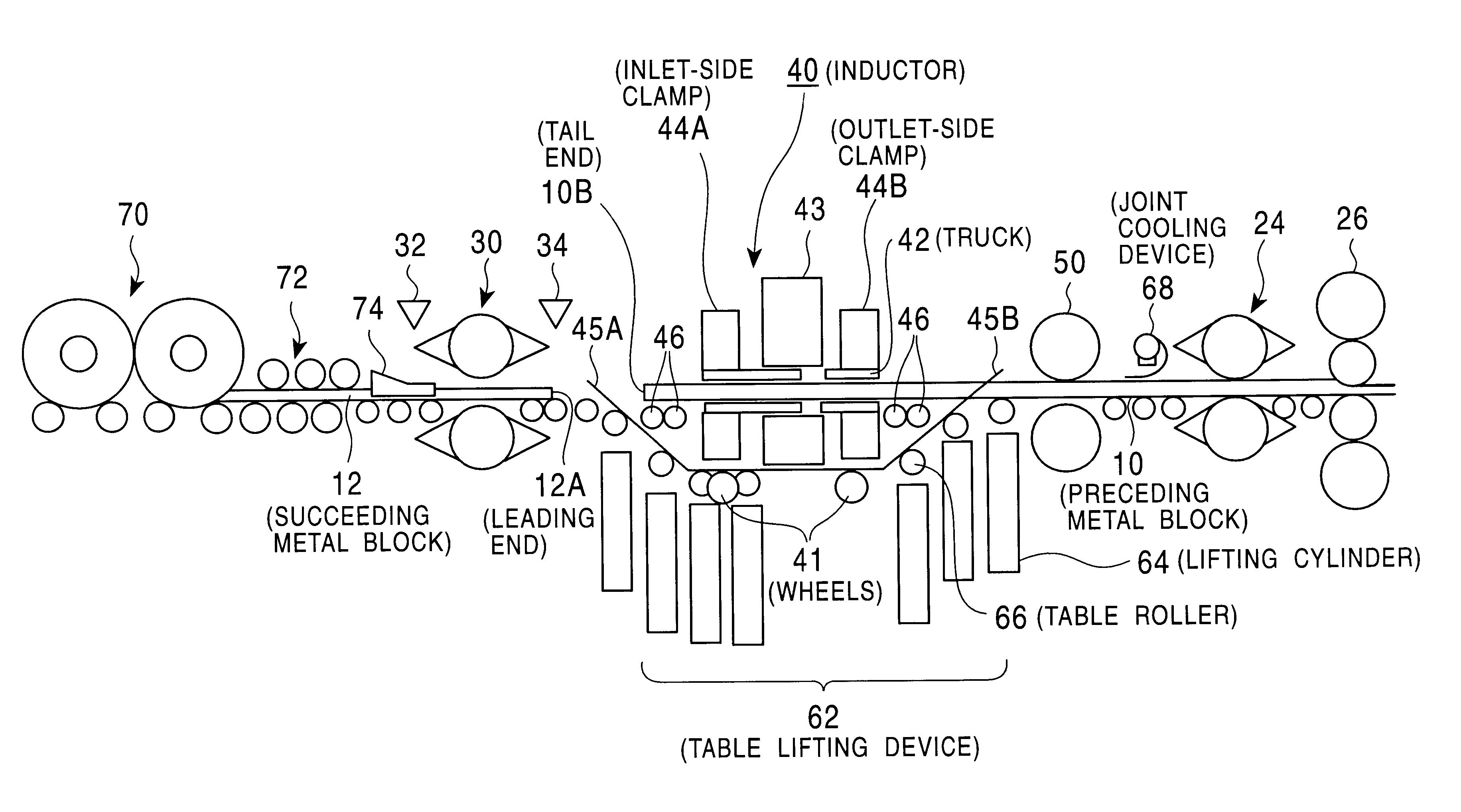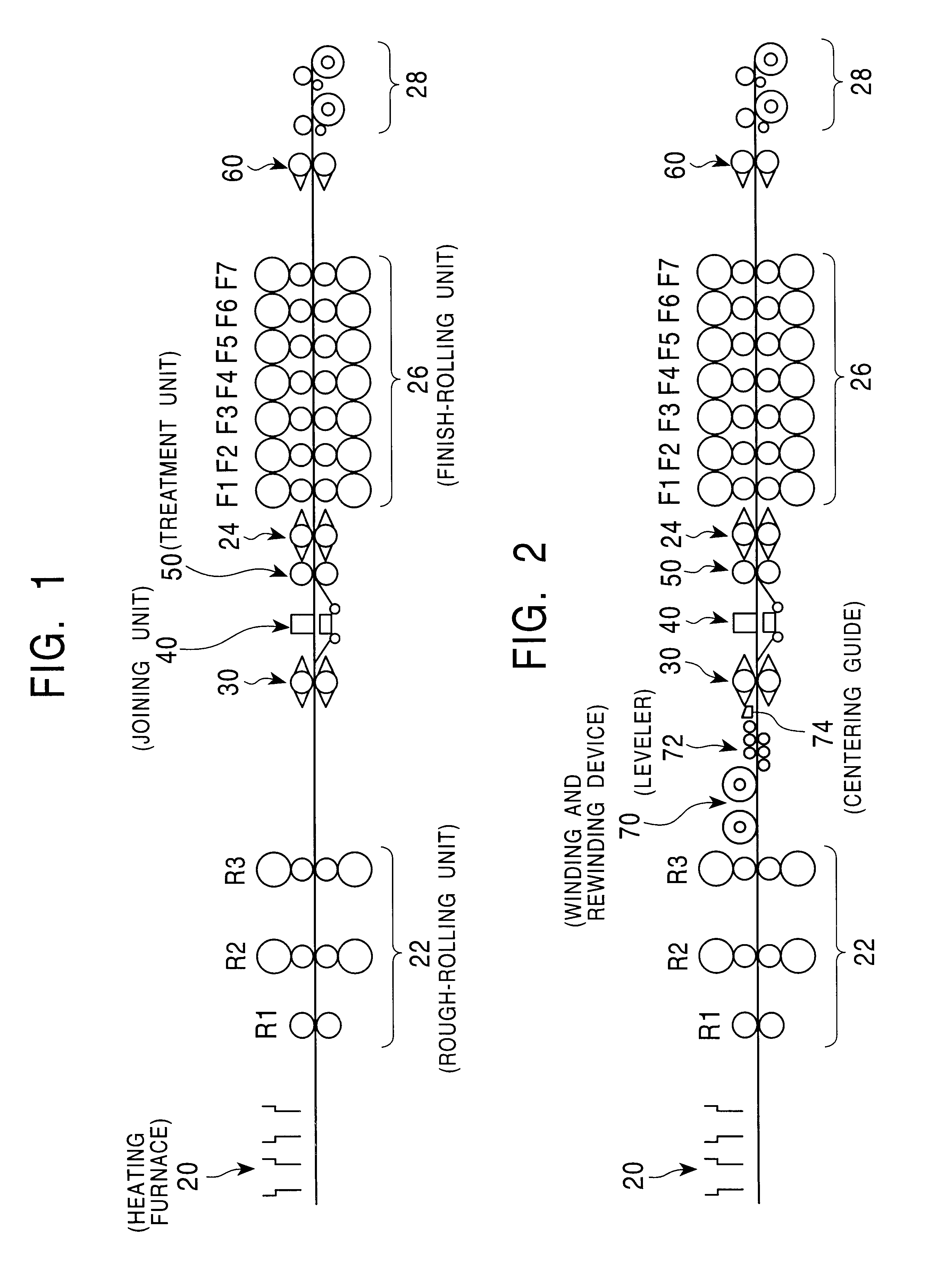Method of hot-rolling metal pieces
a metal piece and hot rolling technology, applied in the direction of rare end control devices, roll mill control devices, manufacturing tools, etc., can solve the problem of inability to thread the leading end of the succeeding metal block through
- Summary
- Abstract
- Description
- Claims
- Application Information
AI Technical Summary
Benefits of technology
Problems solved by technology
Method used
Image
Examples
example 2
It is assumed that an operation of joining the tail end of the first metal block and the leading end of the second metal block of four blocks to be joined was stopped during endless rolling (the first to fourth are low-carbon steel blocks of 4.0.times.1000 mm).
When the joining operation is aborted, the travel of the joining unit 40 and the feeding of a succeeding metal block 12 are temporarily stopped in synchronized velocity. When the joining operation is aborted, the leading end 12A of the succeeding metal block (second) stopped at a position 8.0 m shifted from the starting position (reference position) in the travel zone of the joining unit 40, as shown in FIG. 8. Subsequently, in a manner similar to that in Example 1, the joining unit 40 moved and stopped at the position 13.50 m, called an intermediate position, so that the relative relationship between the travel stop position of the joining unit 40 and the position of the lifting table be appropriate (Step 270), and the table ...
example 3
It is assumed that the tail end of the second metal block and the leading end of the third metal block of four blocks to be joined were incompletely joined during continuous hot rolling (the first is a low-carbon steel block of 1.2.times.1000 mm, the second is a low-carbon steel block of 1.0.times.1000 mm, the third is a low-carbon steel block of 1.0.times.1000 mm, and the fourth is a low-carbon steel block of 1.2.times.1000 mm).
When joining is incomplete, the joining unit 40 travels to the most downstream end of the travel zone in synchronization with the feeding speed of a preceding metal block 10 and a succeeding metal block 12, and stops there. Furthermore, a command to stop removing defective joint portions (burrs) is issued from the control unit 88 to the treatment unit 50. In response to this command, the treatment unit 50 remains in a cutting standby state (a state shown in FIG. 22), and does not perform a cutting operation. Subsequently, the preceding metal block 10 is auto...
example 4
It is assumed that the tail end of the first metal block and the leading end of the second metal block of four blocks to be joined be joined incompletely during endless rolling (the first to fourth are low-carbon steel blocks of 4.0.times.1000 mm).
Subsequent operations of the joining unit, the treatment unit, and the crop shear are the same as those in Example 3. FIG. 35 shows examples of rolling schedules for the second metal block before and after the joint is cut. FIG. 36 shows target thicknesses of the hot-rolled products.
In Example 4, the second metal block, which serves as a succeeding metal block after the joining trouble arises, was finish-rolled to the initially set thickness of 4.0 mm, and the third and fourth metal blocks were then joined and subjected to continuous rolling.
While the present invention is applied to hot rolling for metal blocks in the above description, it is obvious that the present invention is not applicable only to this, but is similarly applicable to ...
PUM
| Property | Measurement | Unit |
|---|---|---|
| thickness | aaaaa | aaaaa |
| thickness | aaaaa | aaaaa |
| thickness | aaaaa | aaaaa |
Abstract
Description
Claims
Application Information
 Login to View More
Login to View More - R&D
- Intellectual Property
- Life Sciences
- Materials
- Tech Scout
- Unparalleled Data Quality
- Higher Quality Content
- 60% Fewer Hallucinations
Browse by: Latest US Patents, China's latest patents, Technical Efficacy Thesaurus, Application Domain, Technology Topic, Popular Technical Reports.
© 2025 PatSnap. All rights reserved.Legal|Privacy policy|Modern Slavery Act Transparency Statement|Sitemap|About US| Contact US: help@patsnap.com



